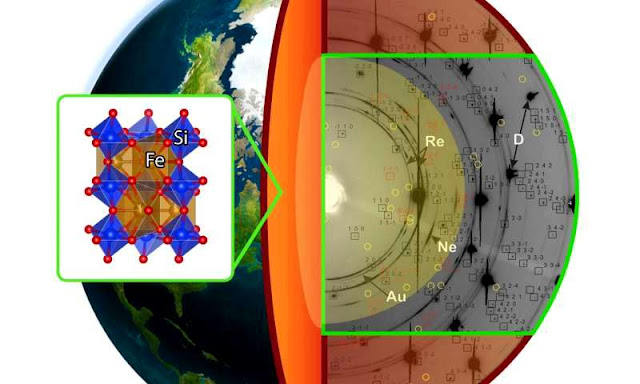Bridgmanite sample found to remain stable at lower mantle conditions
A diverse team of researchers with members from Germany, France, Russia and the U.S. has subjected a sample of bridgmanite to conditions believed to be present at Earth’s lower mantle and has found that it remained stable. In their paper published in the journal Science Advances, the team describes the testing they conducted, what they found and their theory regarding the dynamo effect that is, perhaps, the source of the planet’s magnetic field
Studying the interior of planet Earth is difficult due to the huge scale involved?researchers cannot simply drill a hole all the way to the core to grab samples of material. For that reason, they have developed and used other tools such as seismic monitors to learn more. Though the have learned much, there is still a lot that is unknown or uncertain. One of these uncertainties is the makeup of the planet’s lower mantle?the part just next to the core.
Prior research has indicated that it is likely a mineral called bridgmanite. Other researchers have suggested that bridgmanite would not be stable under the very high temperature and pressure that would exist in the lower mantle. In this new effort, the researchers sought to settle this debate by bringing samples of bridgmanite into their lab and testing it.
To exert very high pressure on the sample similar to that believed to exist in the lower mantle, the researchers used laser-heated diamond anvil cells?creating a vice-like grip by squeezing a very small sample between two diamonds and focusing a laser on them. The team ran several such experiments at different temperatures and pressures, maxing out at 23 gigapascals and 1,800 Kelvin. They then used X-rays to examine the samples to see how they held. The team reports that the samples held up very well and concluded that bridgmanite is stable under the conditions believed to exist at the lower mantle.
The team found that when samples contained different amounts of iron, there were differing levels of stability. Those differences, they suggest, could offer an explanation for seismic activity deep in the planet which could play a role in establishing the dynamo that is responsible for the planet’s magnetic field.
Abstract
The physical and chemical properties of Earth’s mantle, as well as its dynamics and evolution, heavily depend on the phase composition of the region. On the basis of experiments in laser-heated diamond anvil cells, we demonstrate that Fe,Al-bearing bridgmanite (magnesium silicate perovskite) is stable to pressures over 120 GPa and temperatures above 3000 K. Ferric iron stabilizes Fe-rich bridgmanite such that we were able to synthesize pure iron bridgmanite at pressures between ~45 and 110 GPa. The compressibility of ferric iron?bearing bridgmanite is significantly different from any known bridgmanite, which has direct implications for the interpretation of seismic tomography data.
Journal reference: Science Advances
